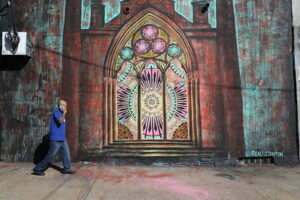Bearings
Mapping the 21st Century Ministry Landscape
By Keith Anderson
September 2014 Issue

As a kid, I loved making maps.
When I was around eight years old, I would ride around our neighborhood for hours on my bike, cruising the sidewalks, streets, alleyways, and dirt trails that connected and intersected the townhomes in our development. When I came home I would record the pathways I discovered on a large map that I had created by taping together the broadsides of brown paper bags. (I was reducing, reusing, and recycling before we even knew what that meant.) Each foray into the neighborhood yielded new discoveries and information, which I recorded onto the map. Eventually, I mapped out our whole neighborhood with a color coded system—black for streets, green for trails, brown for shortcuts, and various colors to mark the little landmarks and treasures only an eight-year-old boy on a bike might notice.
Some things never change.
 These days it seems I’ve traded mapping the streets and trails of my neighborhood for mapping the networked highways and byways of the 21st century ministry landscape.
These days it seems I’ve traded mapping the streets and trails of my neighborhood for mapping the networked highways and byways of the 21st century ministry landscape.
For the last several years I have interviewed ministry leaders who are doing innovative work, visited vital ministry centers, and experimented with new ministry ideas in my own parish. I began mapping these stories on my blog, and then later with Elizabeth Drescher in Click2Save: The Digital Ministry Bible, and now in my forthcoming book, The Digital Cathedral: Networked Ministry in a Wireless World (Morehouse, 2015).
 Like the expansive and varied neighborhood I mapped in my childhood, today’s ministry landscape is not made up of just church buildings, but of the array of local and digital gathering places that comprise widely networked 21st century neighborhoods. Increasingly, as church membership declines and the number of Nones rise, ministry is moving—and must move—from behind the closed doors of our church buildings into local and digital gathering places where people already gather, make meaning, and live out their faith in daily life. These locations include pubs, coffee shops, commuter train stations, bus stops, college campus sidewalks, local vet’s offices, food trucks, laundromats, as well as Facebook, Twitter, Instagram, and other digital social media locales.
Like the expansive and varied neighborhood I mapped in my childhood, today’s ministry landscape is not made up of just church buildings, but of the array of local and digital gathering places that comprise widely networked 21st century neighborhoods. Increasingly, as church membership declines and the number of Nones rise, ministry is moving—and must move—from behind the closed doors of our church buildings into local and digital gathering places where people already gather, make meaning, and live out their faith in daily life. These locations include pubs, coffee shops, commuter train stations, bus stops, college campus sidewalks, local vet’s offices, food trucks, laundromats, as well as Facebook, Twitter, Instagram, and other digital social media locales.
Given this decentralization of ministry practices, the image of a cathedral—a church building writ large—may seem like a strange choice as the title and organizing metaphor for a book on 21st century ministry. However, cathedrals are not merely monumental, self-enclosed buildings. They are networked, relational, incarnational communities that include a variety of spaces with diverse functions and people with differing beliefs and practices. For me, the image of a cathedral evokes a more expansive understanding of what it means to be church today. Bold and towering presences, Cathedrals are deeply connected to their local neighborhoods. They are big enough both physically and spiritually to welcome a range of people, practices, and beliefs. They also transcend many of the false dichotomies between the sacred and the secular, Nones and the religiously affiliated, as well as digital and the face-to-face engagements, that can often limit our understanding of what constitutes ministry and where it happens.
In The Digital Cathedral, I argue that today’s ministry leaders must treat our neighborhoods as our cathedrals, seeing local and digital gathering places as akin to the small chapels and prayer bays housed within the larger expanse of the cathedral. Indeed, in medieval cathedrals, these spiritual sanctuaries hardly exhausted a cathedral’s micro-locales for everyday spiritual engagement. Within the cathedral grounds were granaries, bakeries, breweries, vegetable and ornamental gardens, guest houses, and dining halls. Friday markets and seasonal fairs brought people together at least as often as services on Sundays and holy days. And, as it is today, ministry unfolded throughout all these occasions, sacred and “profane” alike.
I am reminded by my old neighborhood map project that although maps help you get from one place to another, the focus of a map is not so much on the places themselves, but on the roads, alleys, and pathways that connect them. Maps call our attention back to the networks of paths and avenues that form the connective tissue of our communities. Today, in part thanks to the miracle of GPS, we have become disconnected from that character of maps. The GPS dictates directions and we often mindlessly follow along turn by turn without paying attention to the world right outside our windows. In this way, we have perhaps become detached from the neighborhoods we drive through everyday. We seldom stop to really see them. The same can go for our ministries. We can become so focused on what’s happening in our church building and faith community that we miss out on the ways people are connecting with one another, living their lives, and practicing their faith just down the street.
It’s quite likely that I picked up my interest in maps from my grandfather, who worked a cab driver in Baltimore. He knew the streets of city like the back of his hand. When he was on the meter, he would get passengers from Point A to Point B as quickly as possible. But when he was on his own time, driving around his favorite clients—his grandchildren—he insisted we take the back roads, the scenic routes, so we could pay attention to the small details, meet friends and make new acquaintances, and discover beauty amidst the seemingly mundane.
 As ministry leaders in the 21st century, we need to take the time to reacquaint ourselves with our local communities and plug-in to our new digital neighborhoods.
As ministry leaders in the 21st century, we need to take the time to reacquaint ourselves with our local communities and plug-in to our new digital neighborhoods.
Get out of the car. Walk the streets. Log in.
Be intentional about spending time in the places where people gather in your communities. Recognize the holy in your midst. And make it your cathedral.
Photo Credit
Photo: Untitled, by Ariana Prestes, via Unsplash. Licensed under CC0.
Photo: “The iPad of Manhattanhenge" by Timothy Krause, 2011. Licensed under CC2.0.
Photo: Untitled, by Dogancan Ozturan, via Unsplash. Licensed under CC0.
Photo: “Cathedral, Bushwick, Brooklyn," by Timothy Krause, 2013. Licensed under CC2.0.

